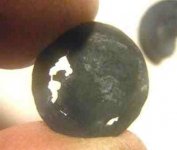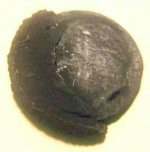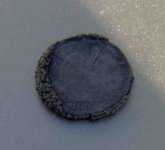Navigation
Install the app
How to install the app on iOS
Follow along with the video below to see how to install our site as a web app on your home screen.
Note: This feature may not be available in some browsers.
More options
You are using an out of date browser. It may not display this or other websites correctly.
You should upgrade or use an alternative browser.
You should upgrade or use an alternative browser.
Capped Bust half dollar!
- Thread starter GatorBoy
- Start date
- Feb 3, 2009
- 41,395
- 158,490
- 🥇 Banner finds
- 1
- Detector(s) used
- Deus, Deus 2, Minelab 3030, E-Trac,
- Primary Interest:
- Relic Hunting
Very cool find, liking the negative imprints to the coin.
hogge
Silver Member
- Mar 13, 2008
- 3,815
- 1,505
- 🥇 Banner finds
- 5
- Detector(s) used
- Teknetics T-2SE--Whites Prism IV
- Primary Interest:
- All Treasure Hunting
Gatorboy, You can quell this debate VERY EASILY. First, if it is a contemporary period CFT, it's probably worth more than the real deal. Take your detector and the coin outside and put it on the ground. Now that it's extracted from the ground you should get a 90+ reading. Weight should be around 13 grams, plus or minus from what has been lost from it. I understand silver turns black, NOT only from salt water conditions, but also from being in the ground for long periods. The problem 1/2 of us have, is the chipping or flaking of the coin. As Kuger said, and I agree, I've never seen silver flake or chip, unless it's been alloyed with other metals, or plated. It may pit, or corrode, but not flake away. This would be a new one on me, but would like to be sure. Counterfeiters were very savy, especially good ones. They could take 2 real coins, melt them down, and make 3 with the right die, and alloyed metals. Making them as close in weight and diameter as possible. So if you have 50 or 60% silver content still in the coin, (hence your blackened color), they can still turn a 50% profit on all three. Upon making thousands of CFT,s.....The profit is enormous. 2 yrs. ago, my brother in-law, dug the most beautiful 8 real you ever want to see. But something wasn't quite right. The weight was different, and it made a funny sound when dropped. (there were also other differences with the coin) A coin in this condition, if regal, would sell between 75-100 on EBAY. But because it was a great looking, WELL MADE, contemporary CFT., he sold it to a fellow C-4 member for $225. I'm not totally convinced that it's CFT, but not totally convinced it's real either. Only you can tell us what you find in testing it. You have alot of knowledgeable people on here trying to figure this one out. Great Find! Hogge
GatorBoy
Gold Member
- May 28, 2012
- 14,716
- 6,156
- Primary Interest:
- All Treasure Hunting
- Thread starter
- #43
I appreciate what your saying.. as Kugar stated..he has never dealt with saltwater found coins... have you? Was the reale found in a saltwater environment?
I have what seems like alot more experience in this area than most who have commented.
The read will not always be in the nineties after over 170 years in salt.
Please just look at some shipwreck found silver.
Also.. the reeded edge on this coin required more than what was necessary to fake a smooth or even lettered edge coin.
Steam power and a sleeved die was used to do that.
I have what seems like alot more experience in this area than most who have commented.
The read will not always be in the nineties after over 170 years in salt.
Please just look at some shipwreck found silver.
Also.. the reeded edge on this coin required more than what was necessary to fake a smooth or even lettered edge coin.
Steam power and a sleeved die was used to do that.
hogge
Silver Member
- Mar 13, 2008
- 3,815
- 1,505
- 🥇 Banner finds
- 5
- Detector(s) used
- Teknetics T-2SE--Whites Prism IV
- Primary Interest:
- All Treasure Hunting
Have you ever seen the edge of an 8 real? Well, my brother in-laws COUNTERFEIT 8 real, had the same "chain link" design around where your reeded edge would be. And this was made 30 years prior to yours. So instead of arguing about it.......take the 1 minute and drop it on the ground....and run your detector over it. If it reads over 90.....case closed.I appreciate what your saying.. as Kugar stated..he has never dealt with saltwater found coins... have you? Was the reale found in a saltwater environment?
I have what seems like alot more experience in this area than most who have commented.
The read will not always be in the nineties after over 170 years in salt.
Please just look at some shipwreck found silver.
Also.. the reeded edge on this coin required more than what was necessary to fake a smooth or even lettered edge coin.
Steam power and a sleeved die was used to do that.
hogge
Silver Member
- Mar 13, 2008
- 3,815
- 1,505
- 🥇 Banner finds
- 5
- Detector(s) used
- Teknetics T-2SE--Whites Prism IV
- Primary Interest:
- All Treasure Hunting
I don't know of a detector out on the market today, that gives readings in the "tenth" of a percent. Maybe some years from now, they will be that precise, but I know my T-2 SE doesn't. You're splitting hairs. Ok...OK.... I'll give you 2% to 87. Now why won't you test it??The 1837 Capped bust half dollar was minted in 89.2% silver and 10.8% copper.
Just want to point that out to you.

recondigger
Bronze Member
- Jul 12, 2012
- 1,223
- 900
- 🥇 Banner finds
- 1
- Detector(s) used
- garrett at4 beach hunter, bounty hunter,CZ-5,CZ-7, Minelab EXP SE, Garrett ACE-150, E-Trac, CTX 3030
- Primary Interest:
- All Treasure Hunting
Erik in NJ
Silver Member
- Oct 4, 2010
- 4,037
- 3,043
- 🥇 Banner finds
- 1
- Detector(s) used
- Minelab Explorer SE Pro & CTX-3030
- Primary Interest:
- Metal Detecting
Here's a trick for removing the black from an old silver coin--wet the coin and wrap it tightly in aluminum foil. It should start to get warm and will smell like rotten eggs. Then wash with soap and water. Repeat till the coin is silver again.
It's a great find whether it's silver or a contemporary counterfeit! Congrats!
It's a great find whether it's silver or a contemporary counterfeit! Congrats!
Last edited:
GatorBoy
Gold Member
- May 28, 2012
- 14,716
- 6,156
- Primary Interest:
- All Treasure Hunting
- Thread starter
- #51
I don't know of a detector out on the market today, that gives readings in the "tenth" of a percent. Maybe some years from now, they will be that precise, but I know my T-2 SE doesn't. You're splitting hairs. Ok...OK.... I'll give you 2% to 87. Now why won't you test it??
I already did that I don't really owe you an answer but it reads between 86 and 88 on several passes.. which is normal.
GatorBoy
Gold Member
- May 28, 2012
- 14,716
- 6,156
- Primary Interest:
- All Treasure Hunting
- Thread starter
- #52
I don't know of a detector out on the market today, that gives readings in the "tenth" of a percent. Maybe some years from now, they will be that precise, but I know my T-2 SE doesn't. You're splitting hairs. Ok...OK.... I'll give you 2% to 87. Now why won't you test it??
I wasn't stating my detector reading just giving you the facts on the coin you want to debate.
GatorBoy
Gold Member
- May 28, 2012
- 14,716
- 6,156
- Primary Interest:
- All Treasure Hunting
- Thread starter
- #53
I Simply shared one of my finds.. if its going to turn into this kind of crap ... I have better things to do.
I don't need any of your " expertise".. I have plenty of my own.
If I had a question I would have asked.
I don't need any of your " expertise".. I have plenty of my own.
If I had a question I would have asked.
GatorBoy
Gold Member
- May 28, 2012
- 14,716
- 6,156
- Primary Interest:
- All Treasure Hunting
- Thread starter
- #55
Also.. that's not a dirt clod I removed from the coin.
Its a crust of silver oxide that happens when saltwater reacts with silver.
Every bit of silver oxide present represents missing silver content in the coin.
Its a crust of silver oxide that happens when saltwater reacts with silver.
Every bit of silver oxide present represents missing silver content in the coin.
Last edited:
BuckleBoy
Gold Member
Love that black sand.. you said it all right there.
Thanks everyone!
Kinda sucked posting something I was really happy about just to have a bunch of people that didn't really know what they were saying..screaming fake..LOL.
Actually, they weren't "screaming fake" just contemporary counterfeit. There is a BIG difference there.
But those of us who know, know saltwater silver when we see it.

Cheers,
Buck
Bill D. (VA)
Silver Member
Here's a trick for removing the black from an old silver coin--wet the coin and wrap it tightly in aluminum foil. It should start to get warm and will smell like rotten eggs. Then wash with soap and water. Repeat till the coin is silver again.
It's a great find whether it's silver or a contemporary counterfeit! Congrats!
Light electrolysis works great too.
hogge
Silver Member
- Mar 13, 2008
- 3,815
- 1,505
- 🥇 Banner finds
- 5
- Detector(s) used
- Teknetics T-2SE--Whites Prism IV
- Primary Interest:
- All Treasure Hunting
OK...I guess I learned a few things from this post. First....What salt water does to a silver coin. And second.....Do not hunt where salt water is, if I am looking for coins. I know that the ocean is a hot bed for newer jewelry, recently dropped coins, and stuff of that nature, and where treasure from shipwrecks has washed ashore. But I'll take an old cellar hole inland anytime. Trust me, I am NOT busting on your find by any means. I still think it is a nice find. But say it was an 1836, rare date bust half? It would be worth the same as what you have in front of you now. About $10 in scrap silver because of the damage. What an absolute shame that would be. It's just the reality of hunting the salt water I guess. IMO....If I lived near the coast I would probably spend more time slightly inland. It's a shame to see a coin like that wasted by salt water. That would be very discouraging to me. Anyways....Thanks for the tutorial and, as a fellow T-Netter, I wish you luck. No hard feelings................ Sincerely Hogge
Top Member Reactions
-
 3461
3461 -
 2058
2058 -
 1968
1968 -
 1164
1164 -
 1109
1109 -
 926
926 -
 831
831 -
 810
810 -
 807
807 -
 789
789 -
 747
747 -
 529
529 -
 480
480 -
 475
475 -
 445
445 -
 423
423 -
E
416
-
 416
416 -
 416
416 -
 392
392
Users who are viewing this thread
Total: 2 (members: 0, guests: 2)
Latest Discussions
-
-
-
They want half of the treasure because they are the reason for knowing the place.
- Latest: Treasure_Hunter
-
-









